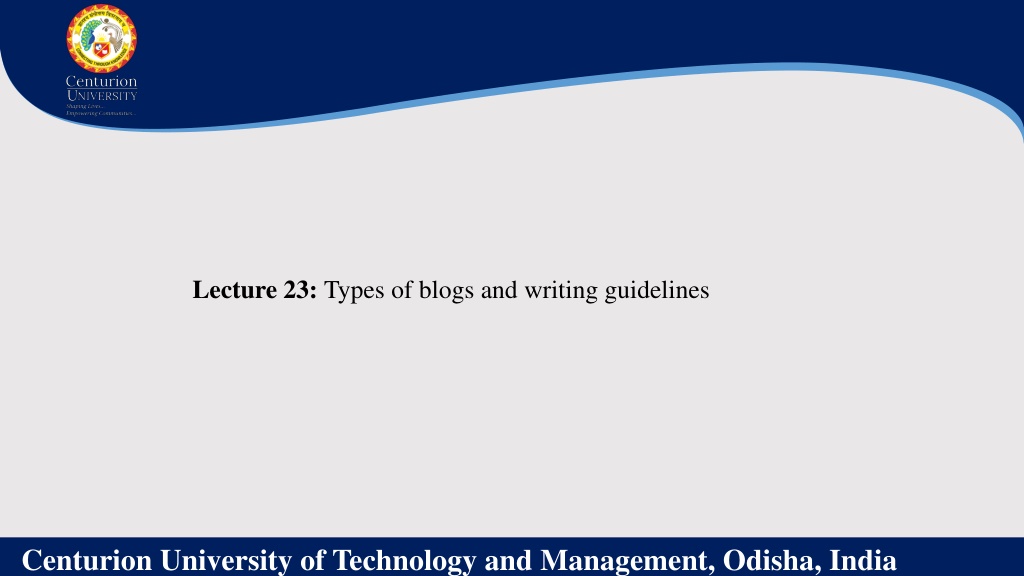Diverse Agricultural Blogging Landscape: Types and Writing Tips
Explore various types of agriculture-related blogs focusing on farming practices, crop-specific information, livestock management, agricultural technology, sustainability, agribusiness, rural lifestyle, agritourism, education, and personal stories. Get insights on writing guidelines and content ideas for agricultural blogging.
Download Presentation

Please find below an Image/Link to download the presentation.
The content on the website is provided AS IS for your information and personal use only. It may not be sold, licensed, or shared on other websites without obtaining consent from the author. Download presentation by click this link. If you encounter any issues during the download, it is possible that the publisher has removed the file from their server.
E N D
Presentation Transcript
Lecture 23: Types of blogs and writing guidelines Centurion University of Technology and Management, Odisha, India
Types of Blogs o Farming Practices and Techniques: These blogs focus on sharing information and insights about various farming practices and techniques. They may cover topics such as organic farming, regenerative agriculture, precision agriculture, hydroponics, crop rotation, soil health, irrigation methods, and pest management. o Crop-Specific Blogs: These blogs concentrate on specific crops or groups of crops. They provide detailed information about cultivation, planting techniques, harvesting, disease and pest control, crop rotation strategies, and crop-specific challenges. Examples include blogs dedicated to corn farming, vineyards, fruit orchards, or specialty crops like mushrooms or herbs. o Livestock and Animal Husbandry: These blogs focus on raising and managing livestock, including topics like cattle farming, poultry farming, beekeeping, fish farming, and animal health and nutrition. They cover aspects such as breeding, housing, feed management, disease prevention, and animal welfare practices. Centurion University of Technology and Management, Odisha, India
o Agricultural Technology and Innovation: These blogs explore emerging technologies, innovations, and trends in agriculture. They cover topics like robotics, artificial intelligence, drone applications, sensor technology, agricultural apps, data analytics, and smart farming solutions. These blogs highlight how technology can improve efficiency, sustainability, and productivity in agriculture. o Sustainable and Organic Agriculture: These blogs emphasize sustainable and organic farming practices, focusing on ecological balance, biodiversity, conservation, and minimizing environmental impact. They may cover topics like permaculture, agroforestry, natural pest control, composting, cover cropping, and alternative energy sources. o Agribusiness and Market Analysis: These blogs provide insights into the business side of agriculture, covering market trends, agribusiness management, supply chain dynamics, marketing strategies, farm economics, and agricultural policy. They offer guidance and information to farmers, entrepreneurs, and those interested in the business aspects of agriculture. Centurion University of Technology and Management, Odisha, India
o Rural Lifestyle and Homesteading: These blogs cater to individuals interested in rural living, self- sufficiency, and homesteading. They cover topics like small-scale farming, gardening, sustainable living, preserving food, DIY projects, and rural lifestyle experiences. o Agri-Tourism and Agritourism: These blogs focus on promoting and exploring the agritourism industry, which involves hosting visitors on farms for recreational and educational purposes. They provide information about farm tours, farm stays, agricultural education, farm-to-table experiences, and rural tourism destinations. o Agricultural Education and Extension: These blogs are dedicated to sharing educational resources, research findings, and practical advice for farmers, students, and agricultural professionals. They cover topics such as agricultural education programs, training opportunities, career paths, grants, and funding options. o Personal Stories and Experiences: These blogs feature personal narratives, stories, and experiences of individuals involved in agriculture. They offer a glimpse into the daily lives, challenges, successes, and lessons learned by farmers, ranchers, or agricultural enthusiasts. Centurion University of Technology and Management, Odisha, India
Blogs Writing Guidelines Understand Your Audience: Identify and understand your target audience within the agricultural community. Consider their interests, knowledge level, and specific needs. Tailor your content to address their challenges, provide practical advice, and offer relevant information. Choose Relevant Topics: Select topics that are timely, useful, and aligned with the interests of your audience. Keep up with industry trends, emerging technologies, best practices, and current events in agriculture. Conduct research and stay informed to provide accurate and up-to-date information. Provide Practical Advice: Share practical tips, techniques, and actionable advice that farmers and agricultural professionals can apply in their work. Offer step-by-step instructions, troubleshooting tips, and real-life examples to make the content more relatable and applicable. Be Accurate and Credible: Ensure that your content is accurate, reliable, and backed by credible sources. Cite reputable studies, research papers, and industry experts when presenting information. Fact-check your content to maintain credibility and build trust with your audience. Centurion University of Technology and Management, Odisha, India
Use Clear and Accessible Language: Use language that is clear, concise, and accessible to your target audience. Avoid technical jargon or explain any specialized terms you use. Make your content easy to understand for farmers and individuals with varying levels of agricultural knowledge. Incorporate Visuals: Include relevant visuals such as images, infographics, charts, and videos to enhance your content. Visuals can help clarify concepts, break up text, and make your blog posts visually appealing and engaging. Ensure that the visuals are of high quality and support the message you're conveying. Structure Your Blog Posts: Organize your blog posts with a clear structure that is easy to follow. Use headings, subheadings, bullet points, and paragraphs to break down information and improve readability. Consider using lists or numbered steps when providing instructions or tips. Write Engaging Introductions: Grab readers' attention with a compelling introduction that hooks them from the start. Highlight the value they will gain from reading the blog post and address their pain points or interests. Centurion University of Technology and Management, Odisha, India























